
The shuttering of the American economy has led to unprecedented hardships for an unprecedented number of Americans and their families. A recent interim economic projection from the Congressional Budget Office (CBO) shows us how the pandemic-induced recession will impact overall economic growth in both 2020 and 2021. The CBO's projections include two economic metrics; unemployment and economic output. We will start by examining the CBO's projections for employment followed by the projections for economic growth.
1.) Employment projections: Between February and April 2020, the number of people employed in the United States dropped by more than 25 million and the size of the overall labor force fell by more than 8 million with the labor force participation rate falling by 3.2 percentage points since February, ending April at 60.2 percent, an unprecedented fall since 1948. Between the third week of March and the first week of May, more than 30 million unemployment claims were filed, pushing the unemployment rate from 3.5 percent in February to 14.7 percent in April. As shown on this graphic, the CBO's estimate projects that unemployment rate will reach 15.8 percent in the third quarter of 2020:
Job losses were concentrated in industries that rely on person-to-person contact including retail trade, leisure and hospitality, education and health services. The leisure and health services sector was the hardest hit, losing 8 million of its 17 million jobs in March and April alone as shown here:
Thanks to the mass furloughs and layoffs that resulted from the shuttering of businesses, 25.6 million fewer people are projected to be employed in the second quarter of 2020 than were employed in the fourth quarter of 2019. This reflects an increase of 17.8 million unemployed (the unemployment effect) and a reduction of 7.8 million in the labour force (the labor force effect). Here is the CBO's projections for employment over the next two years, combining both the unemployment and labor force effects:
2.) Economic Output: Over the next two years, economic activity is projected to fall by the greatest amount in the second quarter of 2020 with real GDP expected to pick up during the second half of wow as shown here:
The CBO projects that real GDP will shrink by 37.7 percent in the second quarter of 2020 and nominal GDP will shrink by 38.7 percent. Even with reasonable economic growth over the second half of 2020 and all of 2021, real economic output is expected to be 1.6 percent lower in the fourth quarter of 2021 than it was in the fourth quarter of 2019. Consumer spending, the key to economic growth in the United States, is projected to be 2.9 percent lower in the fourth quarter of 2021 than it was in the fourth quarter of 2019.
To put these economic output numbers into perspective, the CBO projects that over the decade between 2020 and 2030, GDP output could be $15.7 trillion lower than what the CBO had been projecting in CBO had been projecting in January 2020. This equals 5.3 percent of lost GDP over the next decade. Here is a graphic from the CBO's June 1, 2020 letter to the Senate showing the collapse in GDP:
Here is a graphic showing the percentage drop in real GDP and nominal GDP from the January 2020 analysis to the May 2020 analysis (i.e. the impact of the COVID-10 economic shuttering):
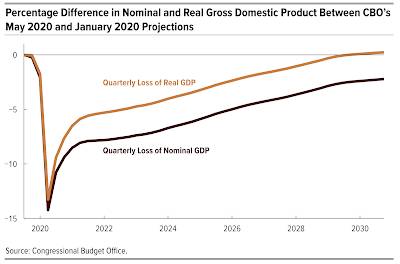
Let's summarize with this table showing the CBO's economic projections for 2020 and 2021:
There is no doubt that the unprecedented shuttering of the economy during the COVID-19 pandemic has led to a new economic reality for millions of American workers who may well find themselves having to change careers or remain unemployed as corporations attempt to maintain new social distancing regulations. Given that the American economy relies on consumer spending for over two-thirds of its size as shown here:
…the economy and will continue to sputter until America's furloughed workers sense that they, once again, have job security and are willing to consume.
Click HERE to read more from this author.
You can publish this article on your website as long as you provide a link back to this page.

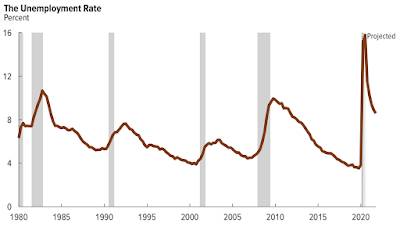
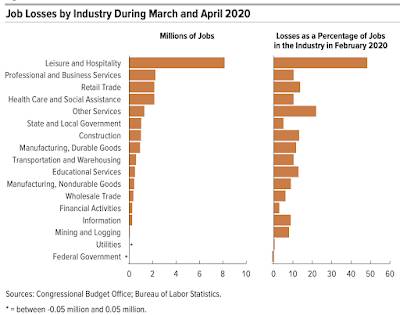
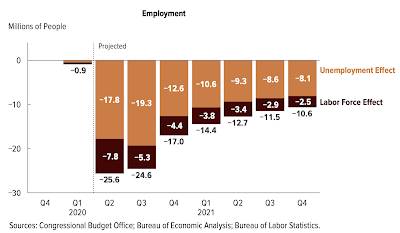
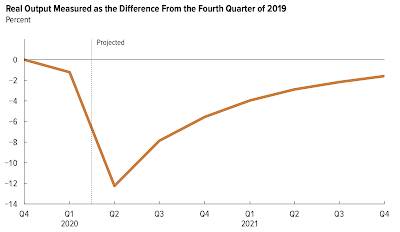
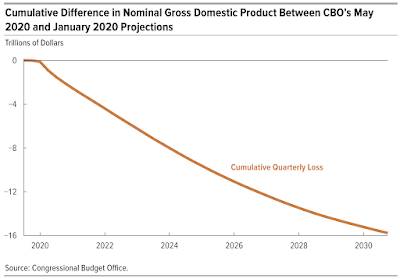
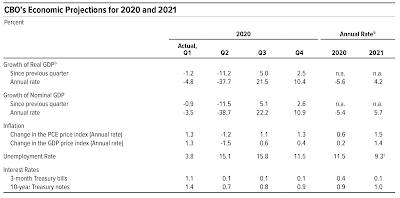

Be the first to comment